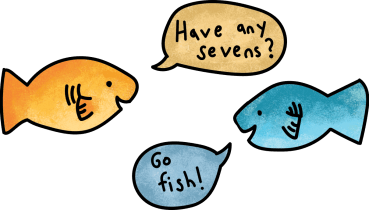
What it is: A simple and educational math game
Best for: Young kids who can (or are learning to) add single-digit numbers, two to five players. It’s a great game for addition practice!
What you need: A deck of face cards (or we’ve been playing with Rook cards)
How to play: First, shuffle the cards and deal six cards to each player. Place the remaining cards in a stack face-down in the middle of the table.
In “Addition Go Fish,” players collect cards and try to form sets. In regular Go Fish, sets are formed by finding cards that are the same, but in this game, sets are formed by gathering cards that add up to a certain number. For example, we’ve been playing with Rook cards and searching for sets that add up to 15 (because the cards are values 1 to 14).
Players get sets by asking another player for a specific card. So, for example, say it’s Carson’s turn. One of his cards is a 9, so he knows if he gets a 6 he can add it to the 9 and get 15. He might say, “Annelise, do you have a 6?” If she does, she gives it to him, and Carson lays down his 6 and his 9 (now a set) in front of him. If Annelise doesn’t have a 6, she says, “Go fish,” and Carson draws a card from the deck in the middle of the table. Then it’s the next player’s turn. Players take turns until the deck is gone and no one can make any more sets. The player with the most sets wins.
Some rules and points:
- A set can consist of any number of cards. (For example, a 9 and a 6 could form a set. So could an 11 and a 4; a 7 and two 4s; or a 2, 4, 3, and 6.)
- Any time a player asks someone for a card and gets the card they asked for, the player gets to go again; they get another turn. This can happen more than once per turn; it happens as often as a player gets a card they asked for.
- Say Carson had a 9 and asked Annelise for a 6, she didn’t have one, she said “Go fish,” Carson drew a card, and he just happened to draw a 6. He can still lay down the 6 with his other card for a set, but he doesn’t get to go again.
- If for some reason a player asks someone else for a card and gets it but doesn’t yet form a set, the player still gets to go again. For example, say I have a 4 and I’m looking to make 15. I know I need an 11. But I’ve asked everyone for an 11 and I know no one’s got one. However, I have a high suspicion Carson has a 9 (because he’s been asking for a 6). I can ask Carson for his 9; then I’ll get a card and, even though I don’t yet have a set, I’ll get to go again, and now I can start asking for a 2 (because 9 plus 4 equals 13, and I would need 2 more to make 15). (Though the children playing this game most likely won’t be using that level of strategy, and maybe you won’t either, if you’re playing with kids like mine whose feelings get hurt if they lose by too much.)
- If a player has a set in their hand, they lay it down immediately; this can happen when they first get dealt cards, if someone gives them a card, or if they happen to draw a card that makes a set.
- If a player runs out of cards, they draw two from the deck and keep playing.
- Unlike regular Go Fish, if Carson asks for a 6 and Annelise has two of them, she only has to give Carson one.
If you want to play with regular cards, take out all of the Kings, Queens, and Jacks and only play with the cards with number values (1 to 9; Aces can be 1s). Play for sets that add to 10. You can add to sets of any number you choose. You could play with Uno cards. You could even incorporate subtraction, or create two-digit numbers and add or subtract those. What variations can you come up with?